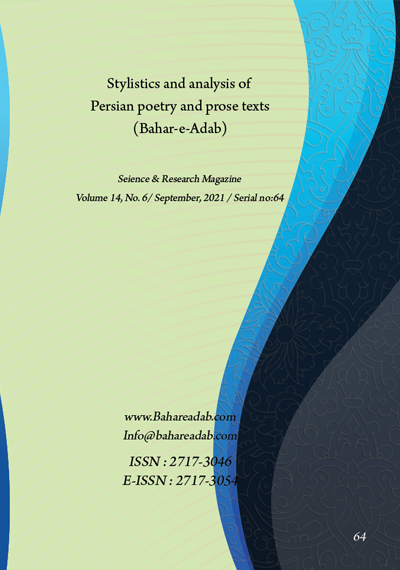- Count View : 402
- آدرس کوتاه شده مقاله: https://bahareadab.com/article_id/1135
- کد doi مقاله: Doi: 10.22034/bahareadab.2021 .14 .5519
Journal of the stylistic of Persian poem and prose
volume Number 14،
number In Volume 6،
،
issue Number 64
Cognitive_Critical Analysis of Metonymy in Malk Alshoara Bahar’s Poems
Hossein Mohammad Sadeghi , Zahra Babasalari (Author in Charge), Maryam Parhizkari , Naghmeh Hosseini
Abstract
BACKGROUND AND OBJECTIVES: The present article is going to make a survey on methonemy in Bahar’s Poems based on Littlemore’s (2015) point of view. From this cognitive model, 12 functions are mentioned for metonymy: 1. Referential; 2. Highlighting and construal; 3. Illocutionary functions of metonymy; 4. Relationship; 5. Anaphoric reference, cohesion and coherence; 6. Exophoric reference building and the establishment of discourse communities; 7. euphemism; 8. Hyperbole; 9. irony; 10. Vagueness; 11. Evaluation, ideology, and positioning; 12.Creativity
METHODOLOGY: This study has been done based on critical_discreptive method. In this study, all methonymy’s functions are surveyed in Bahar’s Poems and then calculated, in order to identify which conceptual methonomy with how much frequency has been used.
FINDINGS: The result showed that the poet has been used all 12 metonymies in his poems with different percentage.
CONCLUSION: We found three most used roles “referential functions, highlighting and construal, illocutionary functions” and the least used one with the least frequency “relationship-building and the establishment of discourse communities”. The other finding showed that these methonymies are used for transferring poet’s messages like patriotic value and religious ideas, for different group of addressees.
Keyword
Cognitive linguistics
, Cognitive Semantics
, Metonymy
, Malk Alshoara Bahar
, Poem
- Bahar, Mohammad Taqi. (2008). Poetry Divan, Tehran: Negah.
- Barcelona, A. (2012). Metonymy-guided inferences in creative thinking (humor, theology and art). Paper presented at the 9th Conference of the International Association Researching and pplying Metaphor. Lancaster, United Kingdom.
- Hasandokht Firooz, Sima. And Gulfam, Arsalan. (2009). A Study of the Metaphor of Time from a Cognitive Perspective in Forough Farrokhzad's Poems, Literary Criticism Quarterly, No. 7, pp. 121-136.
- Kazeruni Mojarad, Zahra. (2017). Permissible Cognitive Study in Rahi Moayeri's Poems, Master Thesis, Payame Noor University of Bushehr, p.18.
- Kovecses, Zoltán (2010). Metaphor: A Practical Introduction. 2nd ed, New York: Oxford University Press.
- Lakoff, G. & Johnson, M. (1980). Metaphors We Live by. Chicago: Chicago University Press.
- Littlemore, J. (2015). Metonymy: Hidden Shortcuts in Language, Thought & Communication. Cambridge: Cambridge university press.
- Panther, K. U., & Rudden, G. (2012). Antonymy in language structure and use. In M. Brdar, Raffaelli and M. Žic Fuchs (eds.) Cognitive Linguistics between Universality and Variation. Newcastle upon Tyne: Cambridge Scholars Publisher, pp 161-188.
- Pfaff, K., Gibbs, R., & Johnson, M. (1997). Metaphor in using and understanding euphemism and dysphemism. Applied Psycholinguistics, 18 (1), pp 59–83.
- Poorabrahim, Shirin. (2019). Critical Cognitive Analysis Permitted in Electoral Headlines of Iranian Newspapers, Journal of Linguistic Research, 11 (2), Ordinal Issue 21, pp. 96-81.
- Shamisa, Sirus. (2009). Bayan, Tehran: Ferdows, p.44.

